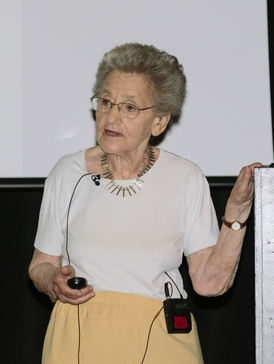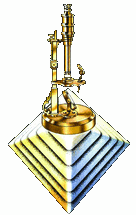Paul Peter Ewald, FRS was a German crystallographer and physicist, a pioneer of X-ray diffraction methods.
Hugo M. Rietveld was a Dutch crystallographer who is famous for his publication on the full profile refinement method in powder diffraction, which became later known as the Rietveld refinement method. The method is used for the characterisation of crystalline materials from X-ray powder diffraction data. The Rietveld refinement uses a least squares approach to refine a theoretical line profile until it matches the measured profile. The introduction of this technique which used the full profile instead of individual reflections was a significant step forward in the diffraction analysis of powder samples.

Olga Kennard, Lady Burgen was a Hungarian-born British scientist who specialised in crystallography. She was the founder of the Cambridge Crystallographic Data Centre.
Diffraction topography is a imaging technique based on Bragg diffraction. Diffraction topographic images ("topographies") record the intensity profile of a beam of X-rays diffracted by a crystal. A topography thus represents a two-dimensional spatial intensity mapping of reflected X-rays, i.e. the spatial fine structure of a Laue reflection. This intensity mapping reflects the distribution of scattering power inside the crystal; topographs therefore reveal the irregularities in a non-ideal crystal lattice. X-ray diffraction topography is one variant of X-ray imaging, making use of diffraction contrast rather than absorption contrast which is usually used in radiography and computed tomography (CT). Topography is exploited to a lesser extends with neutrons, and has similarities to dark field imaging in the electron microscope community.
The International Union of Crystallography (IUCr) is an organisation devoted to the international promotion and coordination of the science of crystallography. The IUCr is a member of the International Council for Science (ICSU).
Acta Crystallographica is a series of peer-reviewed scientific journals, with articles centred on crystallography, published by the International Union of Crystallography (IUCr). Originally established in 1948 as a single journal called Acta Crystallographica, there are now six independent Acta Crystallographica titles:
A crystallographic database is a database specifically designed to store information about the structure of molecules and crystals. Crystals are solids having, in all three dimensions of space, a regularly repeating arrangement of atoms, ions, or molecules. They are characterized by symmetry, morphology, and directionally dependent physical properties. A crystal structure describes the arrangement of atoms, ions, or molecules in a crystal.
Eleanor Joy Dodson FRS is an Australian-born biologist who specialises in the computational modelling of protein crystallography. She holds a chair in the Department of Chemistry at the University of York. She is the widow of the scientist Guy Dodson.
S. Narasinga Rao is an American academic and former Dean of Jackson College of Graduate Studies and Research at the University of Central Oklahoma (1996–2006).

Mamannamana Vijayan was an Indian structural biologist.
Henri A. Levy was an American physicist and crystallographer who made contributions in the field of neutron scattering by crystalline materials.

The International Organization for Biological Crystallization (IOBCr) is a non-profit, scientific organization for scientists who study the crystallization of biological macromolecules and develop crystallographic methodologies for their study. It was founded in 2002 to create a permanent organ for the organization of the International Conferences for the crystallization of Biological Macromolecules (ICCBM). The ICCBM conferences are organized biannually with venues that change regularly to maintain an international character. The objective of the IOBCr is the exchange of research results and encourage practical applications of biological crystallization. It organizes and supports interdisciplinary workshops. The attendance at the ICCBM meetings includes bio-crystallographers, biochemists, physicists, and engineers. The last International Conferences on Crystallization of Biological Macromolecules ICCBM15 was held in Hamburg, Germany.
Frank Harmsworth Allen FRSC CChem (1944–2014) was an internationally recognised crystallographer.

In the field of cryogenics, helium [He] is utilized for a variety of reasons. The combination of helium’s extremely low molecular weight and weak interatomic reactions yield interesting properties when helium is cooled below its critical temperature of 5.2 K to form a liquid. Even at absolute zero (0K), helium does not condense to form a solid under ambient pressure. In this state, the zero point vibrational energies of helium are comparable to very weak interatomic binding interactions, thus preventing lattice formation and giving helium its fluid characteristics. Within this liquid state, helium has two phases referred to as helium I and helium II. Helium I displays thermodynamic and hydrodynamic properties of classical fluids, along with quantum characteristics. However, below its lambda point of 2.17 K, helium transitions to He II and becomes a quantum superfluid with zero viscosity.
Quantum crystallography is a branch of crystallography that investigates crystalline materials within the framework of quantum mechanics, with analysis and representation, in position or in momentum space, of quantities like wave function, electron charge and spin density, density matrices and all properties related to them. Like the quantum chemistry, Quantum crystallography involves both experimental and computational work. The theoretical part of quantum crystallography is based on quantum mechanical calculations of atomic/molecular/crystal wave functions, density matrices or density models, used to simulate the electronic structure of a crystalline material. While in quantum chemistry, the experimental works mainly rely on spectroscopy, in quantum crystallography the scattering techniques play the central role, although spectroscopy as well as atomic microscopy are also sources of information.

Margaret Cairns Etter, known informally as Peggy Etter, was an American chemist who contributed to the development of solid state chemistry for crystalline organic compounds. She is known for her work characterizing and classifying contacts by hydrogen bonds in organic compounds. Her "enlightened imagination, innovative creativity, and unfailing enthusiasm" is recognised as having a "transformative effect" in many areas of organic chemistry.
Aafje Looijenga-Vos was a Dutch crystallographer. She was a professor for general chemistry and later for structural chemistry at the University of Groningen.
This is a timeline of crystallography.
John R. Helliwell is a British crystallographer known for his pioneering work in the use of synchrotron radiation in macromolecular crystallography.
The German Crystallographic Society is a non-profit organization based in Berlin. As a voluntary association of scientists working in crystallography or interested in crystallography and other people and institutions, its goal is to promote crystallography in teaching, research and industrial practice as well as in the public, in particular by fostering the exchange of experience and ideas as well as further education at national and international level Frame. Working groups are dedicated to specific areas of crystallography. The Society has just over 1000 members.





